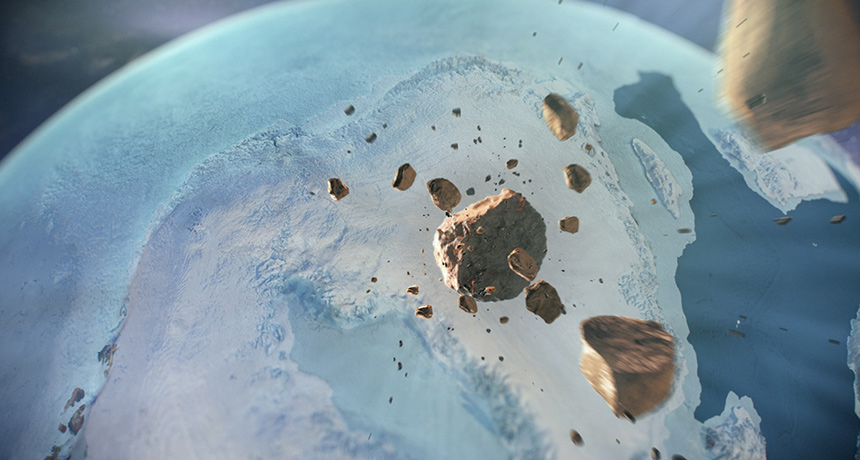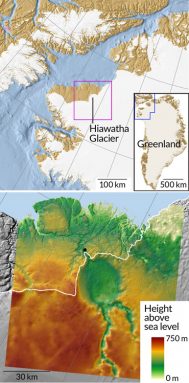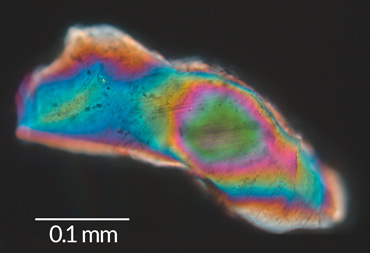A massive crater hides under Greenland’s ice
The asteroid collision that caused it may have triggered a period of cooling called the Younger Dryas

An iron-rich asteroid breaks up in Earth’s atmosphere in this artist’s conception. It suggests the event that long ago created a large crater in northwest Greenland.
Natural History Museum of Denmark, Cryospheric Sciences Lab/GSFC/NASA
Share this:
- Share via email (Opens in new window) Email
- Click to share on Facebook (Opens in new window) Facebook
- Click to share on X (Opens in new window) X
- Click to share on Pinterest (Opens in new window) Pinterest
- Click to share on Reddit (Opens in new window) Reddit
- Share to Google Classroom (Opens in new window) Google Classroom
- Click to print (Opens in new window) Print
Something big lurks beneath Greenland’s ice. Using ice-penetrating radar, scientists have discovered a crater larger than the city of Paris. This 31-kilometer- (19.3-mile-) wide pit in northwest Greenland lies buried under as much as 930 meters (3,000 feet) of ice.
It was formed by a meteorite that slammed into Earth. Scientists now calculate that this space rock must have been about 1.5 kilometers (0.9 mile) across. One so big would have caused notable environmental damage across the entire Northern Hemisphere, a new analysis finds. Glaciologist Kurt Kjær led the team that found this crater. He works at the University of Copenhagen in Denmark.

No one yet knows how old the crater is. But glacial debris and computer studies on rates of ice flow suggest the asteroid impact might have happened between 2.6 million and 11,700 years ago. That was during what is known as the Pleistocene Epoch (PLY-stuh-seen EP-ok).
The newfound crater could breathe new life into a controversial idea. It argues that an impact some 13,000 years ago triggered a mysterious 1,000-year cold snap. Scientists refer to that surprise cold period as the Younger Dryas.
Members of the research team first spotted hints of the crater in 2015. They were curious about a big rounded shape at the edge of Hiawatha Glacier in northwest Greenland. It showed up in a radar scan of the region. NASA’s Operation IceBridge was flying an aircraft over the area. It was part of a program to map the thickness of ice at Earth’s poles. The rounded shape looked like it might mark the edge of a crater, Kjær says.
His team decided to take a more detailed look. They hired a plane from Germany’s Alfred Wegener Institute. Its radar sent pulses of energy toward the ice at a large number of frequencies. Using data collected between 1997 and 2014 by several NASA programs, as well as lots of data collected in 2016 with this “ultra-wideband radar,” the team mapped its target.
The object is almost certainly an impact crater, Kjær says: “It became clear that our idea had been right from the beginning.” It is the first crater found in Greenland and one of the 25 or so largest ever spotted on Earth. And, Kjær adds, from its elevated rim to its bowl-shaped depression, this crater has held its shape beautifully.
His team reported its new find November 14 in Science Advances.
Hidden in plain sight
“It’s so conspicuous in the satellite imagery now,” says team member John Paden. He’s an electrical engineer at the University of Kansas in Lawrence. “There’s not another good explanation,” he says.
On the ground, the scientists hunted for chemical and geological clues of an asteroid impact. They couldn’t sample the crater. It remains buried under deep ice. But just beyond the edge of the ice, meltwater from the base of the glacier has, over the years, washed rocky sediment out of the glacier. The scientists sampled this so-called “outwash.”

It contained several telltale signs of an impact. These included grains of quartz, a crystalline mineral, that had been “shocked.” This means it had deformed portions and glassy bits that might be flash-melted rock. The sample also contained amounts of certain elements that were higher than what’s normally found in Earth’s crust. These included nickel, cobalt, platinum and gold.
That grouping of elements points to an asteroid impact, the researchers say. And it suggests that the space rock would have been a relatively rare iron meteorite.
Figuring out when it slammed into Earth is trickier.
The ice-penetrating radar revealed that the crater’s bowl contains several different layers of ice. There appears to be continuous sequence of layers. They would have come from the gradual deposits of snow and ice through the most recent 11,700 years of Earth’s history. That period is known as the Holocene (HO-loh-seen).
Below that “well-behaved” layer is an older, debris-rich layer. It is one that has been seen elsewhere in ice cores from Greenland. That debris-strewn layer is thought to represent a cold period known as the Younger Dryas. It spanned from about 12,800 to 11,700 years ago. Beneath that is another large layer that is jumbled and rough.
“You see folding and strong disturbances,” says study coauthor Joseph MacGregor. He’s a glaciologist with Operation IceBridge. “And below that, we see yet deeper, complex basal ice.” Radar images showed the bottommost ice inside the crater was not flat but instead had curious peaks. MacGregor says these could represent material from the ground that got trapped in the ice.
Trying to date the cratering event
“What you have is a snapshot of an ice sheet that looked fairly normal during the Holocene, but was quite disturbed before that,” Kjær says. He says that clearly suggests the impact is at least 11,700 years old. The rim of the crater appears to cut through an ancient channel for a river that must have flowed across the land before Greenland became covered with ice roughly 2.6 million years ago.
That time span — essentially, the entire Pleistocene Epoch — is a large range. The team is now working to narrow the range in its likely age. To do that, they’ll look at more sediment. They’ll also run computer models of the rate of ice flow. They may even study ice cores collected from within the crater. The age range for the impact that caused the crater includes the onset of the Younger Dryas.
Planetary scientist Clark Chapman works at the Southwest Research Institute in Boulder, Colo. “There are plenty of roughly circular landforms on Earth of many different sizes,” he notes. Most of them are not impact craters. Still, he says, the paper presents several clues that strongly support the object being a crater.
But Chapman thinks it’s “quite unlikely” that the crater formed within the last couple of million years. Such strikes are rare, he notes. Asteroids barreling into Earth are far more likely to land somewhere in an ocean, he points out. And, he adds, “It would be at least a hundred times less likely that it could have happened so recently as to have affected the Younger Dryas.”
Whenever the crater formed, it is “a straight-up exciting discovery,” MacGregor says. “And we’re just happy not to have to keep it a secret anymore.”
SN/Youtube







